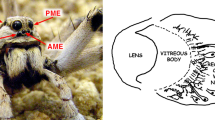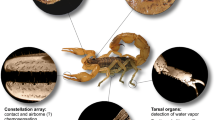Abstract
Previous studies on the homing of the wolf spider Lycosa tarantula have shown that it is carried out by path integration. Animals using this mechanism must measure the distance walked and the angles turned. This study aims to understand if wolf spider L. tarantula is able to estimate the walked distance in an outward path. As this information is more likely obtained by proprioceptive mechanisms, active or passive displacements have been performed. An active locomotion was found essential to estimate distances. During passive locomotion, spiders searched for their burrows near the release point while when displaced actively the inbound journey was longer than the outbound one. The possible use of visual landmarks near the burrow was also tested as a cue to complete the inbound journey. Our results did not show that L. tarantula used these visual landmarks to find the burrow. L. tarantula seems to use only proprioceptive information obtained during the outbound path to estimate the distance traveled.




Similar content being viewed by others
References
Cheng K, Wehner R (2002) Navigating desert ants (Cataglyphis fortis) learn to alter their search patterns on their homebound journey. Physiol Entomol 27:285–290
Dacke M, Srinivasan MV (2007) Honeybee navigation: distance estimation in the third dimension. J Exp Biol 210:845–853
Esch HE, Burns JE (1995) Distance estimation by foraging honeybees. Naturwissenschaften 82:38–40
Esch HE, Zhang SW, Srinivasan MV, Tautz J (2001) Honeybees dances communicate measured by optic flow. Nature 411:581–583
García Jiménez MV (1995) El método experimental en la investigación psicológica. EUB, Madrid
Görner P (1958) Die optische und kinästhetische Orientierung der Trichterspinne Agelena labyrinthica. Z Vergl Physiol 51:111–153
Görner P, Claas B (1985) Homing behavior and orientation in the funnel-web spider, Agelena labyrinthica Clerck. In: Barth FG (ed) Neurobiology of arachnids. Springer, Berlin, pp 275–297
Hoefler CD, Jakob EM (2006) Jumping spiders in space: movement patterns, nest site fidelity and the use of beacons. Anim Behav 71:109–116
Kovoor J, Muñoz-Cuevas A (1996/1997) Comparative structure of the visual system of lynx spiders (Oxyopidae) and its relation to habitat and behaviour. Zool Anz 235:133–145
Kovoor J, Muñoz-Cuevas A, Ortega-Escobar J (1993) Microanatomy of the anterior median eyes and its possible relation to polarized-light reception in Lycosa tarantula (Araneae, Lycosidae). Boll Zool 60:367–375
Land MF (1985) The morphology and optics of spider eyes. In: Barth FG (ed) Neurobiology of arachnids. Springer, Berlin, pp 53–78
Magni F (1966) Analysis of polarized light in wolf-spiders. In: Bernhard CG (ed) The functional organization of the compound eye. Pergamon, Oxford, pp 171–186
Magni F, Papi F, Savely HE, Tongiorgi P (1964) Research on the structure and physiology of the eyes of a lycosid spider. II. The role of different pairs of eyes in astronomical orientation. Arch Ital Biol 102:123–136
Müller M, Wehner R (1988) Path integration in desert ants, Cataglyphis fortis. Proc Natl Acad Sci U S A 85:5287–5290
Narendra A (2007) Homing strategies of the Australian desert ant Melophorus bagoti. I. Proportional path-integration takes the ant half-way home. J Exp Biol 210:1798–1803
Narendra A, Cheng K, Wehner R (2007) Acquiring, retaining and integrating memories of the outbound distance in the Australian desert Melophorus bagoti. J Exp Biol 210:570–577
Nørgaard T (2005) Nocturnal navigation in Leucorchestris arenicola (Araneae, Sparassidae). J Arachnol 33:533–540
Nørgaard T, Henschel JR, Wehner R (2003) Long-distance navigation in the wandering desert spider Leucorchestris arenicola: can the slope of the dune surface provide a compass cue? J Comp Physiol A 189:801–809
Nørgaard T, Henschel JR, Wehner R (2006) The night-time temporal window of locomotor activity in the Namib Desert long-distance wandering spider, Leucorchestris arenicola. J Comp Physiol A 192:365–372
Nørgaard T, Henschel JR, Wehner R (2007) Use of local cues in the night-time navigation of the wandering desert spider Leucorchestris arenicola (Araneae, Sparassidae). J Comp Physiol A 193:217–222
Nørgaard T, Nilsson D-E, Henschel JR, Garm A, Wehner R (2008) Vision in the nocturnal wandering spider Leucorchestris arenicola (Araneae: Sparassidae). J Exp Biol 211:816–823
Ortega-Escobar J (2002) Evidence that the wolf-spider Lycosa tarantula (Arachnae, Lycosidae) needs visual input for path integration. J Arachnol 30:481–486
Ortega-Escobar J (2006) Role of the anterior lateral eyes of the wolf spider Lycosa tarantula (Araneae, Lycosidae) during path integration. J Arachnol 34:51–61
Ortega-Escobar J, Muñoz-Cuevas A (1999) Anterior median eyes of Lycosa tarantula (Araneae, Lycosidae) detect polarized light: behavioral experiments and electro-retinographic analysis. J Arachnol 27:663–671
Papi F (1955) Ricerche sull’orientamento astronomico di Arctosa perita (Latr.) (Araneae, Lycosidae). Pubbl Staz Zool Napoli 27:76–103
Papi F (1992) General aspects. In: Papi F (ed) Animal homing. Chapman-Hall, London, pp 1–18
Papi F, Syrjämäki J (1963) The sun-orientation rhythm of wolf spiders at different latitudes. Arch Ital Biol 101:59–77
Papi F, Serretti L, Parrini S (1957) Nuove ricerche sull’orientamento e il senso del tempo di Arctosa perita (Latr.) (Araneae, Lycosidae). Z vergl Physiol 39:531–561
Ronacher B, Wehner R (1995) Desert ants Cataglyphis fortis use self-induced optic flow to measure distances traveled. J Comp Physiol A 177:21–27
Ronacher B, Gallizi K, Wohlgemuth S, Wehner R (2000) Lateral optic flow does not influence distance estimation in the desert ant Cataglyphis fortis. J Exp Biol 203:1113–1121
Rovner JS (1996) Conspecifics interactions in the lycosid spider Rabidosa rabida: the roles of different senses. J Arachnol 24:16–23
Schmid A (1998) Different functions of different eye types in the spider Cupiennius salei. J Exp Biol 201:221–225
Schröer W-D (1976) Polarization sensitivity of rhabdomeric systems in the principal eyes of the funnel spider Agelena gracilens (Arachnida: Araneae: Agelenidae). Ent Germ 3:88–92
Seidl T, Wehner R (2006) Visual and tactile learning of ground structures in desert ants. J Exp Biol 209:3336–3344
Seidl T, Knaden M, Wehner R (2006) Desert ants: is active locomotion a prerequisite for path integration? J Comp Physiol A 192:1125–1131
Seyfarth E-A, Hergenröder R, Ebbes H, Barth FG (1982) Idiothetic orientation of a wandering spider: compensation of detours and estimates of goal distance. Behav Ecol Sociobiol 11:139–148
Si A, Srinivasan MV, Zhang SW (2003) Honeybee navigation: properties of the visually driven “odometer”. J Exp Biol 206:1265–1273
Sommer S, Wehner R (2004) The ant’s estimation of the distance traveled: experiments with desert ants, Cataglyphis fortis. J Comp Physiol A 190:1–6
Sommer S, Wehner R (2005) Vector navigation in desert ants, Cataglyphis fortis: celestial compass cues are essential for the proper use of distance information. Naturwissenschaften 92:468–471
Srinivasan MV, Zhang SW (2004) Visual motor computations in insects. Annu Rev Neurosci 27:679–696
Srinivasan MV, Zhang SW, Bidwell NJ (1997) Visually mediated odometry in honeybees. J Exp Biol 200:2513–2522
Tinbergen N (1932) Über die Orientierung des Bienenwolfes (Philantus triangulum). Z vergl. Physiol 16:305–334
Wehner R, Wehner S (1986) Path integration in desert ants. Approaching a long-standing puzzle in insect navigation. Monitore Zool Ital 20:309–331
Wehner R, Michel B, Antonsen P (1996) Visual navigation in insects: coupling of egocentric and geocentric information. J Exp Biol 199:129–140
Wehner R, Gallizzi K, Frei C, Vesely M (2002) Calibration processes in desert ant navigation: vector courses and systematic search. J Comp Physiol A 188:683–693
Wittlinger M, Wehner R, Wolf H (2007) The desert ant odometer: a stride integrator that accounts for stride length and walking speed. J Exp Biol 210:198–207
Wohlgemuth S, Ronacher B, Wehner R (2001) Ant odometry in the third dimension. Nature 411:795–798
Wohlgemuth S, Ronacher B, Wehner R (2002) Distance estimation in the third dimension in desert ants. J Comp Physiol A 188:273–281
Acknowledgments
We are grateful to Dr. Robert R. Jackson and Dr. Jacqueline Kovoor for critical reading of the manuscript. We thank Dr. Ken Cheng and two other reviewers for their very useful comments. We greatly appreciate E. Ortega-Escobar for his assistance with the preparation of figures. All experiments complied with the current laws of the country (Spain) where they were performed.
Author information
Authors and Affiliations
Corresponding author
Appendix
Appendix
One measure of resolution of a simple eye is the sampling frequency of the retina, ν s, which is the highest resolvable spatial frequency for a grate-like image (Land 1985). The sampling frequency of the retina is given by the following equation (Land 1985):
ΔΦ has been calculated for the four types of eyes in L. tarantula (Kovoor and Muñoz-Cuevas 1996/1997) with the four following results (for females): AMEs, 0.087 radians; ALEs, 0.059 radians; PMEs, 0.022 radians; PLEs, 0.027 radians. Therefore, by applying Eq. 1, we obtained the following values of ν s for the different eyes: AMEs, 5°; ALEs, 3.4°; PMEs, 1.3°; and PLEs, 1.5°. Given the visual fields of the different eyes (Land 1985), the eyes most probably used to discriminate the grating would be the AMEs and the PMEs. The first ones could discriminate the grating at a longer distance than the second ones that would function in the vicinity of the grating.
Rights and permissions
About this article
Cite this article
Reyes-Alcubilla, C., Ruiz, M.A. & Ortega-Escobar, J. Homing in the wolf spider Lycosa tarantula (Araneae, Lycosidae): the role of active locomotion and visual landmarks. Naturwissenschaften 96, 485–494 (2009). https://doi.org/10.1007/s00114-008-0498-1
Received:
Revised:
Accepted:
Published:
Issue Date:
DOI: https://doi.org/10.1007/s00114-008-0498-1




